Ion diffusion may introduce spurious current sources in current-source density (CSD) analysis
- PMID: 28298307
- PMCID: PMC5494370
- DOI: 10.1152/jn.00976.2016
Ion diffusion may introduce spurious current sources in current-source density (CSD) analysis
Abstract
Current-source density (CSD) analysis is a well-established method for analyzing recorded local field potentials (LFPs), that is, the low-frequency part of extracellular potentials. Standard CSD theory is based on the assumption that all extracellular currents are purely ohmic, and thus neglects the possible impact from ionic diffusion on recorded potentials. However, it has previously been shown that in physiological conditions with large ion-concentration gradients, diffusive currents can evoke slow shifts in extracellular potentials. Using computer simulations, we here show that diffusion-evoked potential shifts can introduce errors in standard CSD analysis, and can lead to prediction of spurious current sources. Further, we here show that the diffusion-evoked prediction errors can be removed by using an improved CSD estimator which accounts for concentration-dependent effects.NEW & NOTEWORTHY Standard CSD analysis does not account for ionic diffusion. Using biophysically realistic computer simulations, we show that unaccounted-for diffusive currents can lead to the prediction of spurious current sources. This finding may be of strong interest for in vivo electrophysiologists doing extracellular recordings in general, and CSD analysis in particular.
Keywords: current source density; electrodiffusion; extracellular potential; ion diffusion.
Copyright © 2017 the American Physiological Society.
Figures



References
-
- Aguilella V, Mafé S, Pellicer J. On the nature of the diffusion potential derived from Nernst-Planck flux equations by using the electroneutrality assumption. Electrochim Acta 32: 483–488, 1987. doi:10.1016/0013-4686(87)85018-1. - DOI
-
- Bédard C, Rodrigues S, Roy N, Contreras D, Destexhe A. Evidence for frequency-dependent extracellular impedance from the transfer function between extracellular and intracellular potentials: intracellular-LFP transfer function. J Comput Neurosci 29: 389–403, 2010. doi:10.1007/s10827-010-0250-7. - DOI - PubMed
Publication types
MeSH terms
Substances
LinkOut - more resources
Full Text Sources
Other Literature Sources

